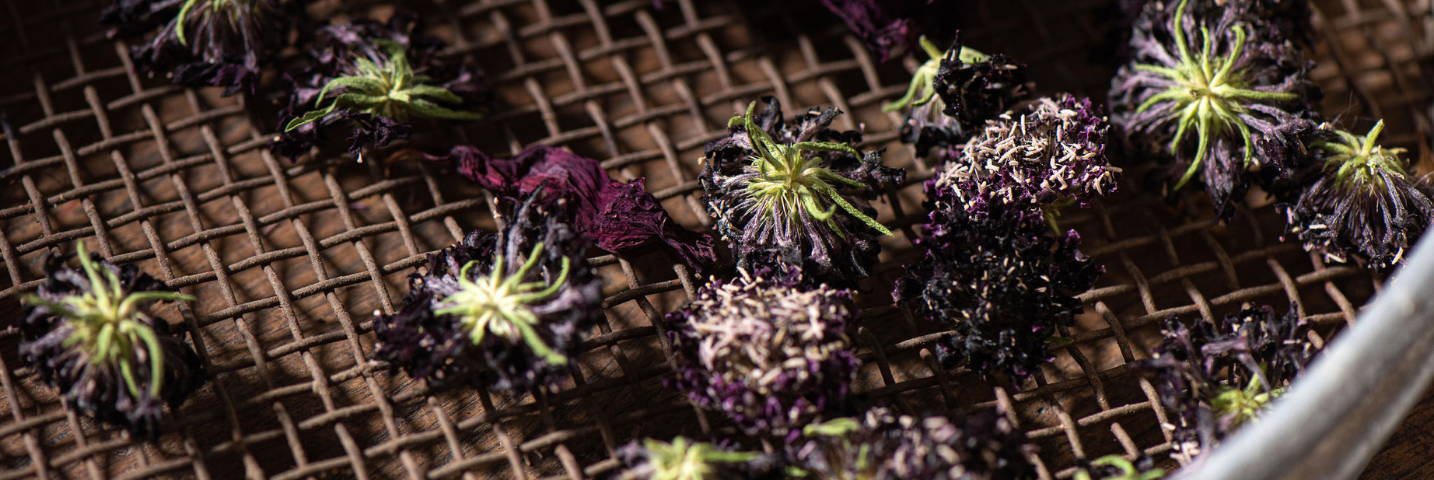
Natural Dye Baby Kit Instructions Guide
Nature is truly extraordinary, it's time to reconnect with it's wisdom and the traditional of natural dyes.
Like all journeys, your natural dye journey will be a personal one. We encourage you to dive deep into nature, to connect with the seasons experiencing all they have to offer and to learn from your journey, always respecting nature as the ultimate teacher.
Some benefits from dyeing with our kits :
Creativity
Joy
Connecting to nature
Respect for the earth
A sustainable point of view
Supporting traditional wisdom & livelihoods
Time with family or friends
Sharing of wisdom through trial & error
Connecting to community

You will need :
An old stainless steel or non reactive pot with lid
Steamer tray (to sit your romper on)
Remember to keep your cooking pots & dyeing pots & utensils separate, don't mix them.
Small mixing vessel
Mixing spoon
Bucket
Rubber Gloves (& face mask if you desire)
Wooden spoon
Tongs
Any extra flowers from personal stocks

Step 1 - PREPARING YOUR ROMPER OR ONSIE

Fill a bucket with hot water to soak your romper overnight

Step 2 - TANNINING
Tannins are needed on cellulose fibres only in preparation for absorption in the mordanting process (step 3).
For lighter shades we recommend preparing your fibre with the either Myrobalan or Gallnut as a tannin and you can use either Powder or Extract versions. For darker shades we recommend using either Cutch or Walnut and again, powder or extracts work.
Recommended is usually 8 - 15% WOF so we go with 10%. Remember that tannins are also dyes so the tannin you select will affect your dye result.
In our kit we have provided Myrobalan as the tannin, a very reliable traditional tannin with a slightly warm tone.
You will need :
Large stainless steel or enamel pot/vat
Tannin 10% WOF
Small mixing spoon
Large wooden spoon
Instructions :
Squeeze out your overnight soaked romper.
Dissolve tannin with hot water in small vessel with spoon.
Fill large pot (enough water to cover your romper) and bring water to 60-65 degrees.
When hot add tannin to mix and stir with large wooden spoon.
Add romper constantly submerging it below the water and removing air bubbles.
Leave romper submerged and continue to rotate below water line for 60mins.
Allow to cool before removing romper and rinse in clean water.
Proceed to mordanting today or leave to dry.
Note : Tannin bath can be re-used so if you have the pots and the space label this and set aside for next time.

Step 3 - MORDANTING
In our Kit we have supplied you Alum acetate 8% WOF.
You will need :
Bucket or vessel
Mordant - Alum acetate 8%
Small mixing spoon
Large wooden spoon
Rubber gloves & mask
Instructions :
Fill large pot (enough water to cover your romper) with warm water from tap 40-50degrees.
Put your mask & gloves on. Dissolve alum acetate with hot water in small vessel with spoon.
Add to pot and stir with large wooden spoon. Remove mask.
Add your wet tannined romper to vessel giving it a stir and leave it submerged below the water removing air bubbles.
Leave sit for 2 hours or as much as overnight, giving it a stir a couple of times during this time.
Remove fibre, squeeze off excess water and hang to dry to leave wet and proceed to dyeing.
Note : Mordant bath can be re-used so if you have the pots and the space label this and set aside for next time.

Step 4 - DYEING
Now your romper is ready to dye!
We have included 3 different dye powders - Marigold gives golds and yellows, Madder gives reds and mixed with marigold gorgeous burnt oranges and cutch gives soft delicate browns. We have also added some dried flowers you might like to sprinkle on as well to see what nature creates for you.
You will need :
Large stainless steel or enamel pot/vat
Dyes
Tongs
Instructions :
Lay out your romper adding desired dye colours and decorating with flowers.
Tightly roll up romper and tie up with jute string.
Cover the base of large pot with hot water from tap and add steaming rack. Place your tied up romper on steaming rack.
Put lid on pot and bring to boil.
Once boiled leave sit for 45mins, turning romper with tongs during time ensuring water is still covering base.
Leave to cool in pot before unwinding. Shake off excess flowers and leave to hang dry.
When dry, lightly steam iron and wash with clean water & natural detergent.
Note : Compost flowers and jute.
Visit our Natural Dye Glossary for more information on Cutch, Marigold & Madder.

Step 5 - CARE following Dye Process
Rinse your dyed fibre and leave to hang dry.
Please visit our Care guide for advice on ongoing care of your natural dye cloth.

Health and Safety
It is advised to wear a mask when weighing out and mixing dyes, fine to remove once dye is in liquid form.
Rubber gloves are recommended when hands go into water with minerals such as Alum, Alum acetate, Iron, Calcium carbonate, Soda Ash.
In regard to the disposal of what you will be using it will be safe to empty onto your garden as there will be an exhausted quantity of alum left in the water. All mordant and tannin baths can be reused with a minimal top up so no need to dispose of after each use, exhaust your baths as much as possible. If uncertain when disposing test the PH level, you are aiming for the neutral zone close to 7.
